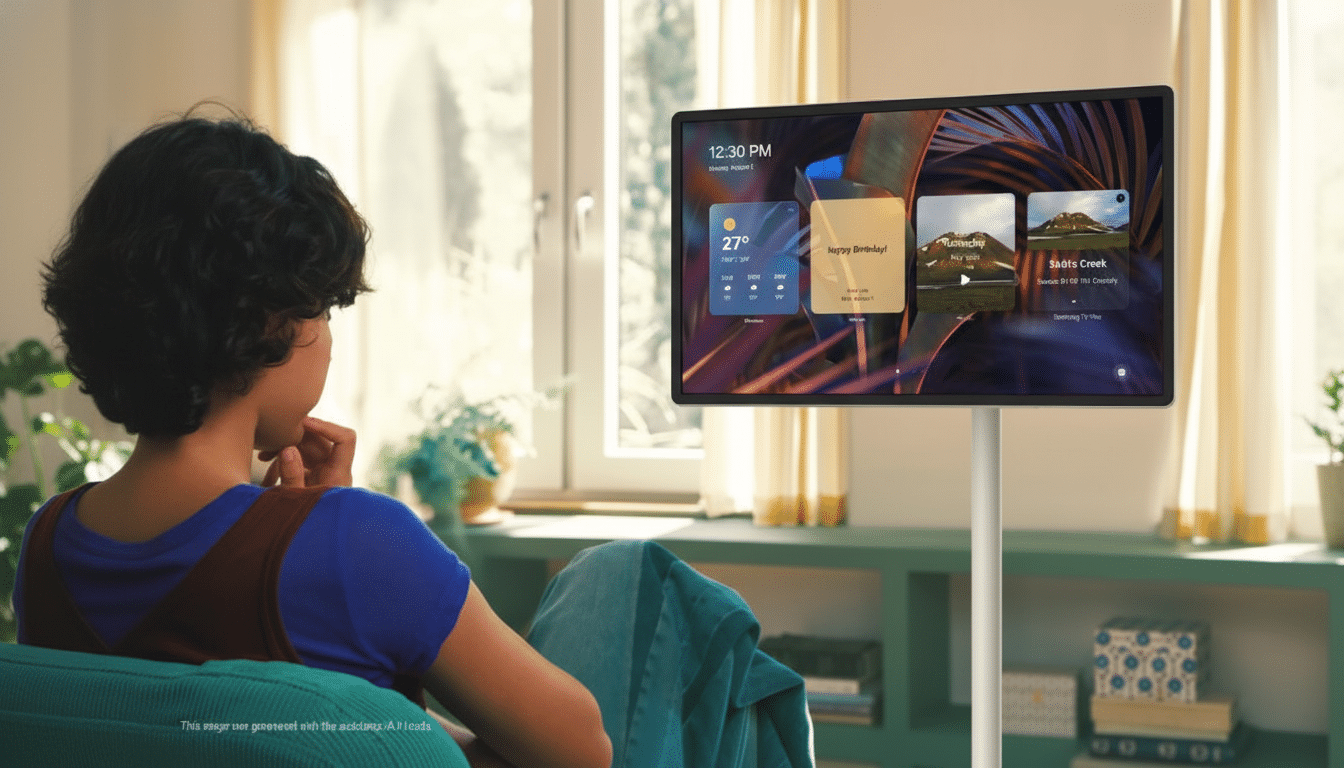Samsung is exploring that concept with a new Movingstyle lineup—spearheaded by the 27-inch QHD touchscreen, which can be unplugged and rolled from room to room. It’s a smart monitor, oversized tablet, and casual TV squeezed into one—minus the cables and the commitment.
What Samsung Is Launching With the Movingstyle Lineup
When you show it off at home, all eyes will be on the 27-inch panel with touch input (up to 20 points of contact) and a svelte bezel that houses four front-facing speakers.

The central component—what’s truly being released here—is locked and loaded with a 120Hz refresh rate (sorry, no display replacement for Alienware units until HP starts making its own displays), adaptive frame rates compatible with whatever AMD card you want to plug in, FreeSync support, and an integrated battery good for up to three hours. It’s engineered to sit on an adjustable kickstand or clamp onto a floor stand with low, discreet wheels, which means it will be easy to park by the couch and pivot toward a kitchen island or wheel into a bedroom for some late-night streaming.
Then there’s a second model, the 32-inch Movingstyle M7 Smart Monitor, which doesn’t go touch but does support 4K resolution. It’s aimed at classic monitor duties—productivity, casual streaming, and console or PC hookups—all while following the same basic point of easy moving around within a home or office.
Like Samsung’s Smart Monitor series, look for built-in streaming apps and casting options in addition to convenience features like remote PC access and mobile integrations such as AirPlay and Samsung DeX support. The pitch is that with it, you bring the screen to your activity instead of the other way around.
Designed to Move Easily at Home and in Dynamic Spaces
The 27-inch touchscreen leans into mobility more than a standard monitor. The rollable stand hides cables; your flat screen lifts up instantly with a simple kickstand if you want to prop it on a table or counter… It’s designed specifically for dynamic spaces like open-plan living rooms, studio apartments, dorms, or home offices that accommodate guests, where wall-mounting or a fixed desk isn’t the most practical option.
The limitation is battery life. It’s not covering a day’s work in three hours, but it will get you through a movie, some TV episodes, a long video call, or maybe an entire recipe video marathon while cooking. And since it’s probably going to spend most of its time right next to outlets, the value here isn’t all-day endurance; it’s about easily relocating without having to trail a power strip and/or HDMI cables across the floor.
Touchscreen Limits, Real-World Uses, and Caveats
And Samsung is wise not to overplay the 27-inch model as a full-blown tablet replacement. There is no stylus support, and there’s only single-finger input when it comes to drawing, so it is better suited for casual interaction than precision sketching. In practice, this is fine—it’s a screen that’s going to do some of its best work when stuck on the wall as a family whiteboard or quick smart-home dashboard or tap-to-play YouTube machine, an approachable display for video calls.

The 120Hz refresh rate is a significant leap above most portable and smart displays. It should feature enhanced frame pacing and deliver snappier scrolling, which can benefit things like cloud gaming or PC mirroring—though the majority of streaming apps top out at lower frame rates. QHD resolution at 27 inches also strikes a good balance in terms of sharpness without pushing the GPU demands of 4K if you do plug in a laptop or small desktop.
Pricing Details and Market Context for Movingstyle Monitors
The Movingstyle screen lands on the much more expensive price point of $1,199.99, marking a premium pitch to a very niche use case.
Pricing for the 32-inch M7 Smart Monitor starts at $699.99; customers purchasing from Samsung’s direct and select retail channels will get a $200 credit. In a world of $300 desk monitors and budget TVs, those prices will get the side-eye—but that’s because the value proposition here is about mobility and onboard smarts rather than raw screen inches per dollar.
The nearest competitor is LG’s StanbyME, a battery-powered 27-inch rolling display that helped to popularize the “TV on wheels” concept. LG’s version normally has an FHD 60Hz panel and has been selling at approximately the $999 mark (depending on region and promotions). Samsung’s counterplay is refresh rate and resolution, making the Movingstyle the more premium option for punchiness and sharpness.
Analysts say that hybrid living—work, entertainment, and communication in the same rooms—has shifted consumers in the direction of adaptable setups. IDC, for example, has noted continuing demand for bigger home screens as remote and hybrid work habits endure. The Movingstyle lineup is a shot straight at that overlap, more of a bridge between categories than simply chasing specs by themselves.
Who Should Consider It and Who Should Wait or Skip
If you’re furnishing a small apartment, shared living room, or a multipurpose home office, the portability will seem liberating. Families that need a screen they can push from the kitchen counter to look up recipes in the morning, into the living room for movies on rainy afternoons, and out onto the balcony for weekend sporting events might find the convenience worth it. A tablet or classic monitor still makes more sense for creators who need pen-grade precision or marathon battery life.
The bottom line is simple: Samsung isn’t looking to win a spec war with a desk-bound monitor. It’s selling freedom of placement. If this is what makes your daily friction go away—fewer cords, less compromise over where you sit and watch and work—then the 27-inch Movingstyle touchscreen might just be the most practical screen you never knew you wanted.

